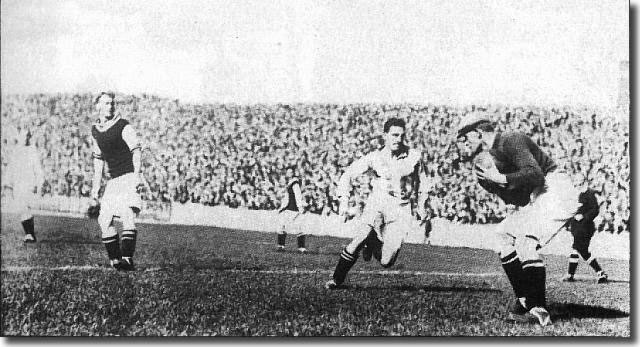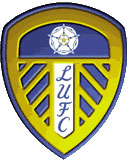|
 After
Leeds United's close brush with relegation in 1925/26,
manager Arthur Fairclough struggled
to bring in any new men in the summer. There was just one arrival - full-back
David Robinson from Solway Star, and he failed to make any impact at Elland
Road. A number of fringe players left the club, including Cuthbert Robson,
John Martin, Len Smith, Tom Duxbury, David Russell and Wilf Chadwick,
but the most notable departure was Jim Baker, off to Nelson Town after
200 league appearances for United. After
Leeds United's close brush with relegation in 1925/26,
manager Arthur Fairclough struggled
to bring in any new men in the summer. There was just one arrival - full-back
David Robinson from Solway Star, and he failed to make any impact at Elland
Road. A number of fringe players left the club, including Cuthbert Robson,
John Martin, Len Smith, Tom Duxbury, David Russell and Wilf Chadwick,
but the most notable departure was Jim Baker, off to Nelson Town after
200 league appearances for United.
The commanding presence of Baker was hard to replace and defensive vulnerabilities
were Leeds' downfall. The offside law had been changed the previous season,
reducing the number of men who had to be between attackers and the goal
line from three to two. Defences were still trying to get to grips with
the new law and find the best way to deal with it, and this year saw a
hatful of goals everywhere.
Like most sides, Leeds benefitted in attack, but struggled at the back.
Tom Jennings, in particular, had a blistering year, easily bettering the
scoring records of both City and United. Billy McLeod had hit 27 for City
in both 1912/13 and 1913/14, while Jennings himself had set the United
scoring record the previous year with 26. In 1926/27, Jennings hit a remarkable
35 goals in the league, with a further two in the Cup.
In a real purple patch between 25 September and 20 November, he netted
19 goals in just 9 matches, with the sequence running thus: 25 September,
3 in a 4-1 win over the previous season's runners-up Arsenal; 2 October,
4 in a 4-2 win at Liverpool; 9 October, 4 in a 4-1 win at home to Blackburn;
16 October, both goals in a 3-2 defeat at Leicester; 23 October, the only
goal in a 3-1 defeat at home to Everton; 30 October, the only goal in
a 4-1 defeat at Huddersfield; 6 November, one in a 2-2 home draw with
Sunderland; 13 November, missed out in 4-2 win against West Brom; 20 November,
hat trick as Leeds beat Bury 4-1. It was a truly remarkable sequence,
coinciding with Leeds' best football of the season.
The Yorkshire Post reported the demolition of Blackburn thus:
'A personal triumph for Jennings, but United had much the stronger half
back line, and Townsley was masterful in his straight and low passing
up the field. Leeds showed good control in a high wind.' Townsley, signed
from Falkirk in December 1925, had begun his Leeds career by replacing
Baker before converting to full-back. But although the half-back line
had been strong against Blackburn, too often it came off second best.
For all Jennings' marksmanship, the defence was shipping goals faster
than he could score them.
Leeds managed to beat Sheffield Wednesday 4-1 on 18 December and overturn
Sunderland 3-2 in the FA Cup Third Round in January, but they were the
only wins between 20 November and 2 April. By then, Leeds had lost more
than half of their 34 league games, with the last one a crushing 6-2 reversal
at Sunderland. They had spent £5,600 in buying Hearts inside-forward John
White in February, but even though he had improved matters, Leeds were
struggling badly. White was an excellent ball player with a sharp turn
of speed, who linked up well with Jennings, Edwards
and outside-right Bobby Turnbull, a tricky darting winger Fairclough had
signed from Bradford Park Avenue in May 1925.
They won three of their last eight league matches, with the most notable
being a 6-3 home win over West Ham on 30 April, their penultimate performance,
but it was all in vain. They were already relegated and a 1-0 defeat in
the final game against Sheffield Wednesday was irrelevant. They had established
a new club scoring record with 69 goals, but they had also conceded a
record 88, far worse than United or City had ever suffered before. They
had managed just 30 points, with only 5 of them coming in away games,
again the worst by either club.
It was a dismal season, and there was little surprise when manager Fairclough
resigned at the end of the season.
Other Football Highlights from 1926/27
- Newcastle's raid into the transfer market in December 1925 paid excellent
dividends when Hughie Gallacher, their £5,500 purchase from Airdrie,
inspired them to their fourth league championship. Gallacher had worked
miracles at the little Lanarkshire club: in three seasons they had won
the Scottish Cup and been league runners-up each year. In 1925/26 Gallacher
had scored 23 goals in just 19 games, but he capped that feat in 1926/27
by establishing a club record with 36 goals in 38 games as Newcastle
comfortably won the title, by five points from Huddersfield Town
- For the first time since the FA Cup was started in 1871 the trophy
left England when Cardiff beat Arsenal courtesy of one of the most incredible
goalkeeping blunders ever seen in a final. 15 minutes from time, Arsenal's
Welsh keeper, Dan Lewis, seemed to have comfortably gathered a 20-yard
shot from Ferguson. Suddenly it slipped out of his grasp and, perhaps
distracted by the onrushing Ferguson and Davies, the Arsenal keeper
struck the ball with his elbow and could only watch helplessly as it
slowly trickled over the line
- Middlesbrough won the Second Division title largely through the efforts
of centre forward George Camsell. His league record of 59 goals made
up almost half of their total of 122, also a league record. Camsell
hit nine hat tricks
- England beat Scotland 2-1 at Hampden Park for the first time since
1904, thanks to two goals from Everton's Dixie Dean, who had now scored
12 goals in five games for his country, including hat tricks against
Belgium and Luxembourg
back to top
|












 After
Leeds United's close brush with relegation in 1925/26,
manager Arthur Fairclough struggled
to bring in any new men in the summer. There was just one arrival - full-back
David Robinson from Solway Star, and he failed to make any impact at Elland
Road. A number of fringe players left the club, including Cuthbert Robson,
John Martin, Len Smith, Tom Duxbury, David Russell and Wilf Chadwick,
but the most notable departure was Jim Baker, off to Nelson Town after
200 league appearances for United.
After
Leeds United's close brush with relegation in 1925/26,
manager Arthur Fairclough struggled
to bring in any new men in the summer. There was just one arrival - full-back
David Robinson from Solway Star, and he failed to make any impact at Elland
Road. A number of fringe players left the club, including Cuthbert Robson,
John Martin, Len Smith, Tom Duxbury, David Russell and Wilf Chadwick,
but the most notable departure was Jim Baker, off to Nelson Town after
200 league appearances for United.